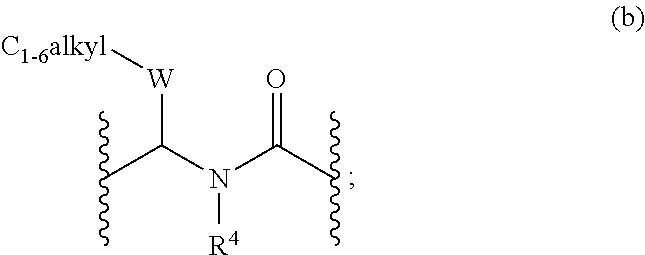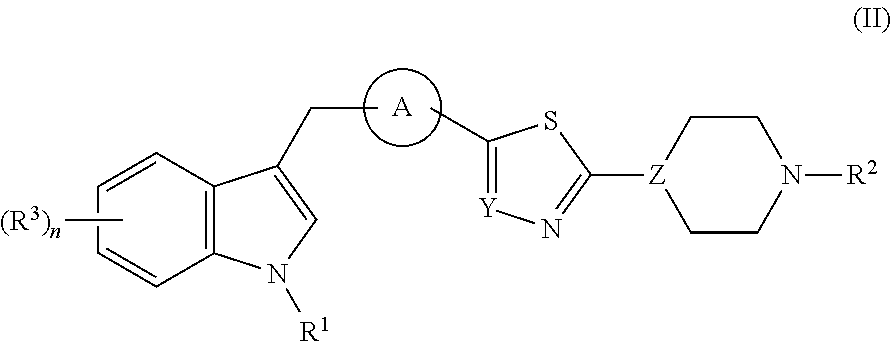Di- and tri-heteroaryl derivatives as inhibitors of protein aggregation
a triheteroaryl derivative and inhibitory technology, applied in the field of diand triheteroaryl derivatives, can solve the problems of protein transcription, autophagy, pore formation, release and/or propagation, and compounds that interfere with syn aggregation,
- Summary
- Abstract
- Description
- Claims
- Application Information
AI Technical Summary
Benefits of technology
Problems solved by technology
Method used
Image
Examples
example 1
5-(5-((1H-indol-3-yl)methyl)-1-butyl-1H-imidazol-2-yl)-2-(4-methylpiperazin-1-yl)thiazole
[0119]
[0120]Step 1. General Procedure for Preparation of Intermediate 2.
[0121]A solution of Intermediate 1 (164.0 g, 1 mol), methyl-piperazine (100.0 g, 1 mol), and K2CO3 (414.0 g, 3 mol) in DMF (1650 mL) was stirred at 140° C. for 12 h. TLC Rf 0.2 (CH2Cl2 / MeOH, 10:1) showed the reaction was complete. The reaction mixture was concentrated and the residue was partitioned between EtOAc and water. The organic layer was dried over Na2SO4, filtered and concentrated. The residue was purified by column chromatography (CH2Cl2 / MeOH, 50:1) to give Intermediate 2 (120 g, 66%) as yellow oil. 1H NMR (400 MHz CDCl3) δ 2.35 (s, 3H), 2.51-2.54 (m, 4H), 3.50-3.53 (m, 4H), 6.56 (d, J=3.6 Hz, 1H), 7.19 (d, J=3.6 Hz, 1H).
[0122]Step 2. General Procedure for Preparation of Intermediate 3.
[0123]To a solution of diisopropylamine (27 g, 0.27 mol) in THF (250 mL) was added n-BuLi (117 mL, 0.27 mol) at −78° C. under N2. T...
example 2
2-(5-((1H-indol-3-yl)methyl)-1-butyl-1H-imidazol-2-yl)-5-(4-methylpiperazin-1-yl)-1,3,4-thiadiazole
[0134]
[0135]Step 1. General Procedure for Preparation of Intermediate 8.
[0136]A solution of ethyl 5-chloro-1,3,4-thiadiazole-2-carboxylate (60 g, 0.313 mol), K2CO3 (130 g, 0.94 mol) and methyl piperazine in DMF (300 mL) was stirred at 40° C. for 3 h. TLC Rf 0.5 (petroleum ether / EtOAc, 10 / 1) showed the reaction was complete. The reaction mixture was poured into water and extracted with. CH2Cl2. The organic layer was washed with water, dried over Na2SO4, and concentrated to give Intermediate 8 (58.5 g, 73%) as a yellow solid. 1H NMR (400 MHz, CDCl3) δ 1.35-1.47 (m, 3H), 2.34 (s, 3H), 2.47-2.60 (m, 4H), 3.60-3.71 (m, 4H), 4.37-4.47 (m, 2H), 5.30 (s, 1H).
[0137]Step 2. General Procedure for Preparation of Intermediate 9.
[0138]To a solution of Intermediate 8 (40 g, 0.156 mol) in THF (400 mL) was added dropwise DIBAL-H (313 mL) at −78° C., stirred at 0° C. for 2 h, and stirred at room tempera...
example 3
2-(5-((1H-indol-3-yl)methyl)-4-butyl-4H-1,2,4-triazol-3-yl)-5-(4-methylpiperazin-1-yl)-1,3,4-thiadiazole
[0151]
[0152]Step 1. General Procedure for Preparation of Intermediate 15.
[0153]A solution of methyl 2-(1H-indol-3-yl)acetate (20.0 g, 0.106 mol), and NH2NH2.H2O (12.5 g, 0.53 mol) in MeOH (200 mL) was stirred at 60° C. overnight. TLC Rf 0.5 (petroleum ether / EtOAc, 4 / 1) showed the reaction was complete. The reaction mixture was concentrated and CH2Cl2 was added to the residue to recrystallize the product. The mixture was filtered and the filter cake was dried by vacuum at 50° C. to give Intermediate 15 (20 g, 100%) as yellow solid. 1H NMR (400 MHz, MeOD) δ 3.61 (s, 2H), 6.99-7.02 (m, 1H), 7.07-7.11 (m, 1H), 7.15 (s, 1H), 7.32-7.34 (d, J=8.4 Hz, 1H), 7.53-7.55 (d, J=8.0 Hz, 1H).
[0154]Step 2. General Procedure for Preparation of Intermediate 16.
[0155]A solution of Intermediate 8 (4.5 g, 17.6 mmol) and n-BuNH2 (5.14 g, 70.32 mmol) in toluene was stirred at 160° C. in sealed tube for 4...
PUM
| Property | Measurement | Unit |
|---|---|---|
| weight | aaaaa | aaaaa |
| temperature | aaaaa | aaaaa |
| temperature | aaaaa | aaaaa |
Abstract
Description
Claims
Application Information
 Login to View More
Login to View More - R&D
- Intellectual Property
- Life Sciences
- Materials
- Tech Scout
- Unparalleled Data Quality
- Higher Quality Content
- 60% Fewer Hallucinations
Browse by: Latest US Patents, China's latest patents, Technical Efficacy Thesaurus, Application Domain, Technology Topic, Popular Technical Reports.
© 2025 PatSnap. All rights reserved.Legal|Privacy policy|Modern Slavery Act Transparency Statement|Sitemap|About US| Contact US: help@patsnap.com



